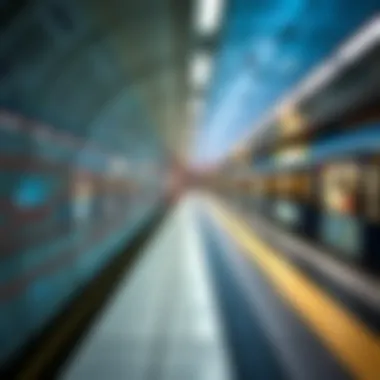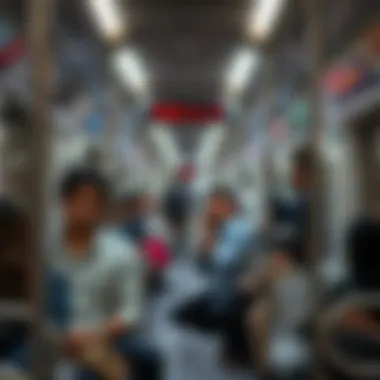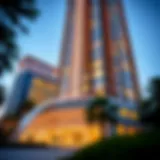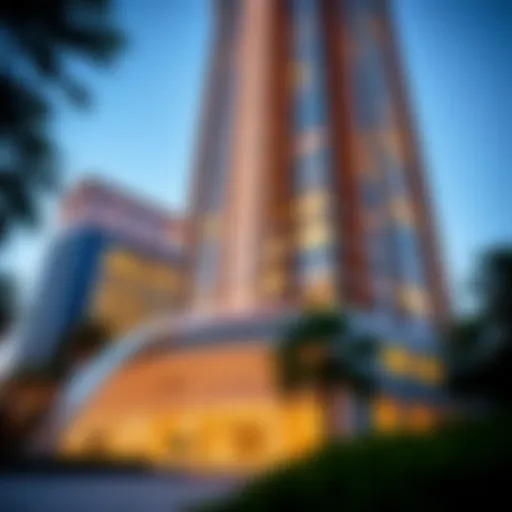Analyzing Dubai Metro Costs: Tickets and Impact


Intro
Navigating the urban landscape of Dubai requires a solid understanding of its public transportation system, particularly the metro. As one of the most modern and efficient transit systems in the world, the Dubai Metro has become a cornerstone for both residents and visitors. But, as with any urban transport system, understanding the costs associated with using the metro is essential.
From ticket pricing to the broader economic implications, this article seeks to dissect the various factors that contribute to the cost of using the Dubai Metro. One might wonder, how does transportation cost impact real estate prices? Can a convenient metro access influence housing decisions?
In this exploration, we will delve into key components including fare categories, real estate market conditions, and future investment insights, shedding light on how the metro fits into the grander scheme of the city's infrastructure and urban planning. By concentrating on the balance between accessibility and affordability, potential investors and home buyers can make more informed decisions regarding their investments in this vibrant city.
As we embark on this detailed examination, expect to see how every fare structure connects with the larger economic landscape. In the spirit of clarity and depth, let’s jump into the latest market trends.
Foreword to the Dubai Metro
The Dubai Metro represents a modern marvel in urban transportation, intricately woven into the fabric of the city’s infrastructure. Its importance goes beyond merely facilitating daily commutes; it symbolizes Dubai’s commitment to innovation and sustainability. The inception of this metro system aimed to provide a quick, efficient alternative to the congested roads, which many residents and visitors navigate daily.
Understanding the Dubai Metro involves recognizing the multitude of benefits it brings to both individuals and the city as a whole. As urban sprawl continues to expand, metro systems like this one offer a lifeline, helping reduce traffic congestion and, subsequently, pollution levels. Given its advanced technology and expanding reach, the metro encompasses an integral role in urban mobility, making it essential for potential residents, investors, and travelers to grasp its implications.
Overview of the Metro System
The Dubai Metro system consists of two main lines: the Red Line and the Green Line. These lines span roughly 75 kilometers, connecting key areas across the city. Launched in 2009, the Red Line primarily runs from Rashidiya to UAE Exchange, while the Green Line connects from Etisalat to Dubai Creek.
What sets the metro apart is its driverless operation and a variety of modern train cars, which provide comfort and efficiency to passengers. With station designs emphasizing aesthetics and functionality, it prioritizes user friendliness. In addition, stations are strategically located near popular landmarks, including shopping malls, business districts, and cultural sites, enhancing accessibility.
Significance in Urban Mobility
The strategic significance of the Dubai Metro in urban mobility cannot be overstated. Metro systems are crucial in urban planning as they facilitate increased efficiency in moving large populations. The metro alleviates pressure on the city’s existing road networks, allowing for smoother traffic flow. On a daily basis, the metro serves thousands of commuters, showcasing its role as a reliable mode of transportation.
Moreover, its operational hours, from early morning until midnight, ensure it caters to a diverse range of users, from early risers to night owls. This flexibility helps meet the demands of a city that pulses with activity around the clock.
In addition to ease of travel, the metro system also promotes sustainability. As many cities face challenges related to pollution and energy use, Dubai has leveraged its metro services to minimize carbon footprints, aligning with global ecological goals.
Communication and integration with other forms of transport, such as buses and taxis, further solidifies the metro’s position as the backbone of modern transit in Dubai.
"The Dubai Metro is more than just a transport system; it’s a blueprint for the future of urban mobility."
In summary, the Dubai Metro not only enhances the daily commuter experience but also significantly contributes to the overarching goals of urban sustainability and economic growth, making it a pivotal element in Dubai's ongoing development.
Dubai Metro Ticket Pricing
Understanding the Dubai Metro Ticket Pricing is essential for anyone navigating the intricate urban landscape of this remarkable city. The ticket prices serve as a critical piece of the puzzle for residents, tourists, and investors alike. An informed perspective on ticket pricing entails considerations that extend beyond the simple act of buying a ticket. It encompasses an evaluation of economic benefits, urban mobility, and the everyday experience of commuters. By diving into the ticket pricing framework, stakeholders can grasp how costs impact travel choices and urban planning in Dubai.
Standard Fare Structure
The fare structure of the Dubai Metro is designed to encourage the use of public transport while managing costs for users effectively. The pricing is not arbitrary; rather, it has been carefully crafted based on several factors such as distance traveled and time of day. The fare structure is generally categorized by zones, with fares increasing with the number of zones traversed. For example, traveling within a single zone typically offers the lowest fare, enhancing accessibility for short-distance commuters. This fosters a culture of public transport use, which is conducive to urban sustainability.
In addition, the Metro employs a cashless ticketing system that streamlines the buying process through the use of NOL cards. This not only makes transactions faster but also encourages users to adopt digital methods, reducing cash handling and improving efficiency overall.
Ticket Types Explained
Different ticket types cater to various travel needs and preferences, and understanding these options can help maximize the value for users.
Single Journey Ticket


The Single Journey Ticket is a popular choice among occasional travelers who need flexibility without heavy commitment. It allows users to hop on the Metro, travel across specified zones, and exit conveniently. This ticket is highly beneficial for tourists visiting certain attractions or residents making infrequent trips. A notable characteristic of this ticket is its simplicity—easy to purchase and valid for short-duration commutes. However, one potential downside is the higher cost per journey compared to multi-ride options, making it less economical for daily users.
Daily and Weekly Passes
Daily and Weekly Passes provide a middle ground for frequent travelers, offering savings for those who travel multiple times within a period. These passes allow unlimited travel across all zones within their validity period. The daily pass is particularly attractive for travelers who may be examining several sites in one day, supporting a more extensive exploration of the city. On the other hand, while the weekly pass offers a good value, it might not benefit those who travel less frequently or whose travels are sporadic. The convenience of accessing the Metro as often as needed without additional fees is a stand-out feature.
Monthly NOL Card
The Monthly NOL Card is designed for dedicated commuters, providing the most cost-effective option for those who regularly use the Metro for work or daily errands. This card features a fixed monthly fee, allowing unlimited travel across all zones, which can save considerable amounts for daily travelers. Its broad acceptance throughout the transport system in Dubai enhances commuting efficiency. However, potential disadvantages include the upfront cost and the necessity of consistent use to realize its economic benefits. If an individual were to miss several days of travel, the card's value may diminish.
Understanding these ticketing options equips users to make informed decisions about their commutes. Each choice reflects not only the user’s travel habits but also significant implications for budgeting and planning, which resonate deeply within the broader framework of urban transit economics.
"Navigating the Dubai Metro's pricing can be a strategic move for not only commuters but also for those observing urban mobility trends."
In summary, comprehending the Dubai Metro Ticket Pricing and the nuances of each ticket type is vital for users looking to optimize their travel experience. This knowledge not only serves practical needs but also invites deeper contemplation about the role of public transport within the economic landscape of Dubai.
Factors Influencing Metro Costs
Understanding the factors that shape the costs associated with the Dubai Metro is crucial for any investor, home buyer, or property manager looking to maximize their experience with this public transport option. Pricing isn't just a random number; it reflects various elements, each intertwined with travel habits, urban planning, and economic dynamics. In this section, we delve into the specific aspects that affect fare pricing and overall metro expenses, ensuring a solid grasp of what contributes to the bottom line.
Distance Travelled
When it comes to the cost of traveling on the Dubai Metro, the distance travelled plays a significant role. The fare structure is designed around the zones you pass through on your journey. Each zone equates to a specific fare increment. For instance, a short trip from one stop to the next may set you back only a few dirhams, while traversing multiple zones can quickly add up.
- Zonal System: The metro operates on a zonal basis, and as you extend your journey across more zones, the cost increases. This system promotes a fair pricing model where passengers only pay for the distance they cover.
- Cost Implications for Daily Commuters: Regular commuters should consider their routes carefully. Those living farther away from the heart of the city might find themselves facing a steeper travel cost compared to those residing closer to major metro access points.
Passengers can further assess their travel costs by utilizing the official RTA app, which offers detailed insights into fares based on zones and stations. For many, planning the ideal travel route not only saves money but also time.
Time of Travel
Time of travel also plays a pivotal role in determining the overall cost and usability of the Dubai Metro. While the fare structure remains constant based on distance, the broader implications of when you choose to hop onto the metro can affect your experience and surroundings significantly.
- Peak vs. Off-Peak Hours: Traveling during peak hours can lead to crowded trains and longer wait times. Although the fare remains unchanged, discomfort can translate into a different kind of cost—your time. The rush hour, typically from 7-9 am and 5-7 pm, sees a surge in commuters, making it less pleasant for those who value personal space.
- Special Events: Certain events around the city can also impact travel. Major exhibitions or celebrations can lead to increased footfall, creating a bustling atmosphere. Understanding this ebb and flow is essential for planning scheduled travel
In essence, the Dubai Metro’s pricing is influenced by factors beyond just the ticket fare—how far you travel and when you decide to make your journey are crucial to grasping the full picture of commuting in this vibrant city.
"Navigating transportation in Dubai is not merely about fares but understanding the broader ecosystem that influences those costs and choices that come with them."
For further details on travel costs, you can check out resources like RTA Dubai or reviews from fellow passengers on Reddit.
Cost Comparisons with Other Modes of Transport
When analyzing the costs related to the Dubai Metro, it’s essential to place these expenses alongside alternative transport options available in the city. Understanding how the metro fares measure up against buses, taxis, and the costs of driving provides valuable insights for residents and visitors alike. This comparison is not just about the money spent; it also involves convenience, time efficiency, and overall accessibility.
Buses in Dubai
Dubai’s bus network is vast and covers extensive areas of the city. The affordability of bus fares makes them a popular choice for many commuters, especially those on a tighter budget. A single journey on a bus costs considerably less than the metro, making it an attractive option if you are not in a rush. Buses have their downsides, such as potentially longer travel times due to traffic and fewer direct routes compared to the metro system.
Another factor to consider is the NOL card, which can be used for both metro and bus travel. When using the bus, passengers can benefit from the following:
- Lower fare structure: Bus fares typically range from AED 3 to AED 7 depending on distance.
- Frequent services: Buses run regularly, providing a dependable option for those not using the metro.
- Accessibility: Buses reach areas that might not be serviced by the metro, especially in suburban neighborhoods.
Taxis and Ride-Sharing Services


Taxis in Dubai offer a comfortable and flexible transportation method, though they come at a higher price. A starting fare for taxis can be around AED 12, plus additional charges based on distance. Ride-sharing platforms like Uber and Careem provide similar pricing dynamics, often slightly less than traditional taxis but still more expensive than the metro. Factors influencing the cost effectiveness of taxis include:
- Surge pricing: Ride-sharing services can see price hikes during peak hours.
- Convenience: Direct door-to-door service is a significant advantage, especially for those with heavy luggage or in a hurry.
- Time-saving: A taxi can slice through traffic faster than waiting for public transport.
Cost wise, if you compare a standard 15-kilometer journey:
- Metro: AED 5 to AED 7 (depending on zones).
- Taxi: AED 40 to AED 60, depending on traffic conditions.
It's clear that while taxis and ride-sharing provide convenience, they carry a heftier price tag than the metro.
Driving Costs: Fuel and Parking Fees
For those who prefer personal vehicles, driving in Dubai has its own cost dynamics. While it offers independence, several expenses must be factored in:
- Fuel Costs: Prices vary but average around AED 2.50 to AED 3.00 per liter.
- Parking Fees: Most commercial and public establishments charge for parking, sometimes quite heavily. Depending on location, fees can range from AED 5 to AED 25 per hour.
- Additional Expenses: Maintenance, insurance, and toll fees (such as those on Sheikh Zayed Road) can add up quickly.
When driving, many commuters also face the pressure of traffic congestion, which may counteract the perceived speed advantage over public transport. Thus, while the flexibility of driving is appealing, economic considerations often favor the metro for many residents.
By weighing these costs and benefits carefully, individuals can make informed choices about their daily transportation and how best to navigate Dubai's busy landscape, contributing to a better understanding of their overall living expenses in the city.
Economic Impact of Metro Costs
The economic ramifications of the costs associated with the Dubai Metro stretch far beyond what many might initially perceive. Understanding this topic is crucial for various stakeholders including investors, home buyers, and property managers. Not only does the metro act as a backbone for urban mobility, but it also weaves into the larger economic fabric of Dubai, influencing behaviors, trends, and investment potential in the real estate sector.
Effects on Daily Commuters
Daily commuters are often viewed as the lifeblood of a city's public transport system. In Dubai, the metro offers a lifeline for individuals traveling to work or school. The ability to navigate the bustling city efficiently and affordably allows for greater workforce participation. With costs drivers kept at bay, the total monthly expense can fall substantially compared to other transport options. Here’s the breakdown:
- Typical Monthly Fare: Commuters who utilize a Monthly NOL Card find themselves saving a considerable amount when compared to daily single journey tickets.
- Time Saved: Efficient metro operations often mean less time spent traveling compared to other forms of transport, which may be stuck in traffic. Time, after all, is money.
- Environmental Impact: By opting for a mass transit option over personal vehicles, commuters contribute to a reduction in carbon emissions, bolstering sustainable practices in urban living.
In essence, the cost efficiency coupled with time savings consolidates a positive experience for daily riders. This satisfaction can lead to a culture of reliance on public transport, ultimately shaping commuting patterns in the long run.
Influence on Real Estate Prices
The interplay between metro costs and real estate is profound. Areas around metro stations often experience an uptick in property values. Here are a few core aspects to consider:
- Increased Desirability: Properties located near metro lines generally attract higher interest. The convenience of having direct access to transport reduces perceived travel hassles, thereby raising the value for rental properties and sales.
- Urban Development: Master-planned communities often align with metro expansion plans, further driving property values. Areas previously thought to be less desirable gain traction and attention as metro lines are integrated.
- Change in Investor Sentiment: Investors often gauge the metro system's reliability when considering property purchases. If the metro is seen as a viable and cost-effective commuting option, investors are more likely to view real estate in proximity favorably.
Furthermore, a rise in property values can lead to broader economic effects, such as increased tax revenues for the government, which can be funneled back into services and infrastructure improvements.
"The metro is not just a mode of transport; it’s a catalyst for economic development and urban revitalization."
Accessibility and Feasibility
Understanding the accessibility and feasibility of the Dubai Metro is crucial for anyone contemplating life and travel in this bustling city. The Dubai Metro is more than just a mode of transport; it plays a pivotal role in shaping urban mobility. The effectiveness of any public transport system directly correlates to its accessibility and usability. In a city marked by rapid growth and a fiercely competitive real estate market, the success of the Dubai Metro hinges on its ability to cater to a diverse population.
When it comes to accessibility, the design of the metro system must consider the various demographics that use it. Individuals from different backgrounds—including residents, workers, and tourists—all rely on this transport system for their daily commutes or explorations. A well-connected metro system can significantly reduce travel times and ease the daily grind of commuting.
Key elements that contribute to the accessibility of the Dubai Metro include:
- Proximity of Metro Stations: Stations are strategically placed throughout the city, making it convenient for users to access them.
- User-Friendly Infrastructure: Each metro station boasts features such as elevators, ramps, and clear signage that facilitate movement for people with disabilities and families with strollers.
- Affordability: As discussed in previous sections, the ticket pricing structure not only reflects value for money but also ensures that using public transport remains accessible to all economic segments.


Metro Stations Coverage
The coverage of metro stations in Dubai is extensive, easing the logistics of urban transportation. Covering the city's quintessential districts, the Dubai Metro connects vital hubs such as Downtown Dubai, Dubai Marina, and Dubai International Airport. With a total of 53 stations across two main lines—the Red Line and the Green Line—commuters find it easy to navigate various routes without the hassle of excessive transfers. This design not only saves time but also reduces reliance on personal vehicles, promoting a greener urban environment.
Significant metro stations include:
- Union Station: A major interchange station linking the Red and Green Lines.
- Dubai Mall/Burj Khalifa Station: Closely situated to one of the world’s largest shopping destinations and landmark attractions.
- Airport Terminal Station: Offering direct access to and from the international airport, catering to the flow of tourists and business travelers alike.
"The strategic placement of metro stations makes hopping on and off almost effortless, transforming how people experience the city."
Integration with Other Transportation Options
The seamless integration of the Dubai Metro with other transportation methods plays a crucial role in enhancing overall accessibility. The design of the metro fosters connection points with buses, taxis, and ride-sharing services, creating a cohesive transport network. This interconnectedness means that users can transition from the metro to various forms of local transport without enduring long waits or unnecessary complications.
Key aspects of this integration include:
- Bus Links: The extensive bus network complements the metro, allowing passengers to reach areas not directly served by rail. Bus stops often abut metro stations, facilitating easy transfers.
- Taxi Services: Designated taxi stands at metro stations provide travelers with immediate access to cabs, ensuring they have options for their onward journey.
- Ride-Sharing: Platforms like Uber and Careem are prevalent in Dubai. Their presence near metro stations further enhances convenience for metro users who prefer personal transport for part of their journey.
Future Developments in the Metro System
The potential transformations in the Dubai Metro system highlight the city's commitment to improving urban mobility. With an ever-growing population and relentless urban sprawl, the future developments of the metro are not just necessary; they are crucial for maintaining efficient transport within the emirate. These advancements promise to enhance connectivity between key areas, reduce transit times, and promote sustainable development. This segment will examine the planned expansions and technological innovations that are set to elevate the metro's functionality and user experience.
Planned Expansions
Dubai has plans to further extend the reach of its metro network significantly. This expansion is designed to accommodate future city growth and anticipated increase in ridership. Some of the proposed lines and extensions include:
- Route 2020: This extension connects the existing Red Line to the Expo 2020 site, providing easy access for residents and visitors.
- Blue Line: Proposed to connect more suburbs and areas not well served currently.
- More Direct Lines to Key Areas: Plans are in discussion to create faster connections to critical zones like the Dubai South area, which is close to the airport, and developments along the Dubai Canal.
These expansions will not only shorten travel times but also increase the metro's coverage area, ensuring that more residents have access to public transport. The benefits are multifaceted: they promise to ease traffic congestion, reduce reliance on individual vehicles, and lower carbon emissions across the city.
Technological Innovations
The Dubai Metro is also set to incorporate cutting-edge technologies that aim to streamline operations and enhance the rider experience. Some key innovations include:
- Smart Ticketing Systems: The move towards contactless payments offers a sleek and time-efficient way for commuters to buy tickets. Travelers may soon use mobile applications or smart wristbands to tap on and off without the need for physical tickets.
- AI-Powered Predictive Analytics: Utilizing artificial intelligence can greatly improve operational efficiency. AI can analyze patterns in ridership, allowing for adjustments in train frequency and capacity to meet demand more effectively.
- Real-Time Information Displays: Future systems may provide real-time updates on train schedules and delays directly on mobile devices, giving passengers more control over their journeys.
- Modernized Infrastructure: With advancements in engineering, both the trains and stations are expected to undergo upgrades that enhance safety and comfort, integrating features like better air conditioning and passenger flow management.
These technological strides not only aim to enhance user satisfaction but also facilitate the metro’s goal of providing a reliable, fast, and comfortable travel experience. As these changes unfold, they will further cement the Dubai Metro's status as a cornerstone of urban transport, reflecting the city’s forward-thinking ethos.
"Investing in robust infrastructure is akin to planting a seed; it blossoms into opportunities and growth for generations to come."
In summary, the future developments in the Dubai Metro system signify not only a response to current demands but also a visionary outlook aiming to meet the needs of a dynamic city. With planned expansions and technology-driven innovations, the metro is poised to become even more integral to Dubai's urban fabric.
Ending
The costs associated with the Dubai Metro extend beyond mere fare prices; they reflect a city's commitment to sustainable urban transport. Understanding the metro's ticket pricing structures and the infectious connectivity it offers is paramount for investors, property managers, and home buyers alike. It provides not just a means of travel, but an economic pulse that beats through the urban landscape, influencing everything from property values to daily commuting habits.
Summary of Key Insights
In this article, we have explored various dimensions related to the costs of utilizing the Dubai Metro:
- Comprehensive Fare Structure: The ticket pricing is designed to cater to different segments of the populace, ensuring affordability for both residents and tourists.
- Influencing Factors: Variables like distance and time significantly affect travel costs, providing a tailored experience for the commuter's needs.
- Economic Ripples: The metro’s operation fundamentally impacts the economic framework of the city, influencing real estate prices and the commuting patterns of daily travelers.
- Integration with Urban Planning: The strategic placement of metro stations fosters new developmental opportunities and encourages urban density, making locations near metro stops increasingly desirable.
These insights encapsulate how a moderately priced transportation system contributes to a flourishing urban ecosystem.
Final Thoughts on Metro Costs
As we consider the financial aspects of the Dubai Metro, it’s crucial to grasp the broader implications it holds for the economic landscape. With its ongoing expansions and technological upgrades, the metro continues to be a significant player in shaping not only mobility but also affordability and accessibility within the Emirate.
Investors and property managers should keep a close eye on how metro developments influence neighborhood dynamics and property values. Understanding the cost of travel within the framework of such an innovative transport system can yield valuable insights—helping them strategize for future investments. Ultimately, the Dubai Metro is a vital thread in the larger fabric of urban development that warrants careful consideration.















